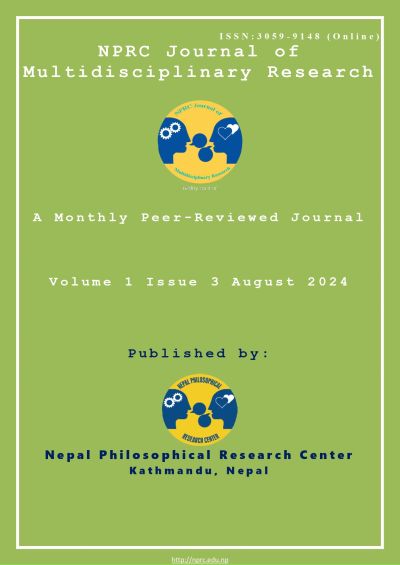Epidemiological Profile of Oral Cancer Patients Attending at B.P. Koirala Memorial Cancer Hospital, Chitwan, Nepal
DOI:
https://doi.org/10.3126/nprcjmr.v1i3.70061Keywords:
Cancer, Dentistry, Oral Health, Oncology, Oral Cancer, NepalAbstract
Background: Oral cancer is one of the most prevalent and leading causes of mortality in certain regions, like South-Central Asia. The incidence of oral cancer in Nepal is also increasing. Oral cancer is preventable and treatable if diagnosed in an early stage. The study conducted at B.P. Koirala Memorial Cancer Hospital (BPKMCH) in Bharatpur, Nepal, was aimed at assessing the epidemiological profile of oral cancer patients attending BPKMCH.
Methods: A descriptive cross-sectional study design was used to assess the epidemiological profile of oral cancer, and 50 patients were included in this study during January to July 2023. A semi-structured interview schedule was developed, which has 3 parts, viz., i. socio-demographic variables, ii. Lifestyle-related factors and iii. Clinical profile of oral cancer, to obtain the information from the respondents.
Results: The study findings revealed that out of 50 majorities of respondents (88%) were male. According to the religion, most of them (84%) were Hindu, and likewise, according to ethnicity, about half of them (40%) belong to Madeshi, followed by 30% Brahmin/Chhetri. Similarly, most of the respondents (90%) were married. Regarding the exposure to risk factors, half of the respondents (50%) had habits of smoking consumption, More than half (68%) had the habit of tobacco consumption, near to half (40%) had the habit of Gudka consumption, and 68% had the habit of alcohol consumption. None of the respondents had the habits of oral sex or a family history of oral cancer. Similarly, about one-third (30%) of respondents had stage IV, followed by 28% stage II, 26% stage I, and only a few (14%) stages in III disease; all the oral cancer was OSCC. Concerning the treatment modalities, 36% of respondents had surgery, near to one quarter (20%) received chemotherapy, 10% received radiation therapy, and 30% of respondents had surgery with adjuvant therapy.
Conclusion: The study found that the majority of oral cancer patients attending BPKMCH were between the ages of 30 and 45 and were predominantly male. Smoking, tobacco, and Gudka consumption are the main risk factors for oral cancer. The risk assessment approach and screening program should be focused on preventing oral cancer.
Downloads
Downloads
Published
How to Cite
Issue
Section
License
Copyright (c) 2024 The Author(s)

This work is licensed under a Creative Commons Attribution-NonCommercial 4.0 International License.
This license enables reusers to distribute, remix, adapt, and build upon the material in any medium or format for noncommercial purposes only, and only so long as attribution is given to the creator.





